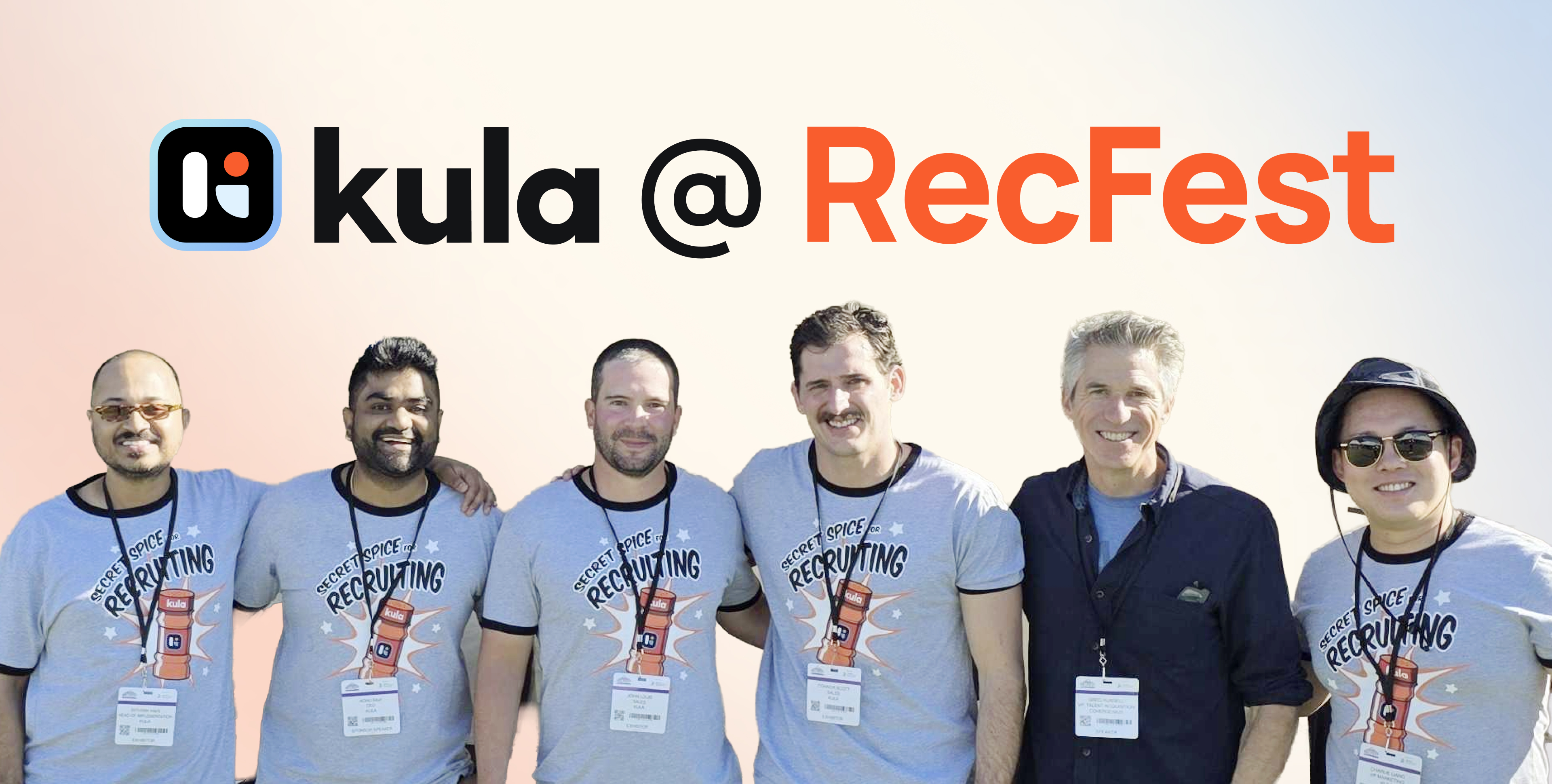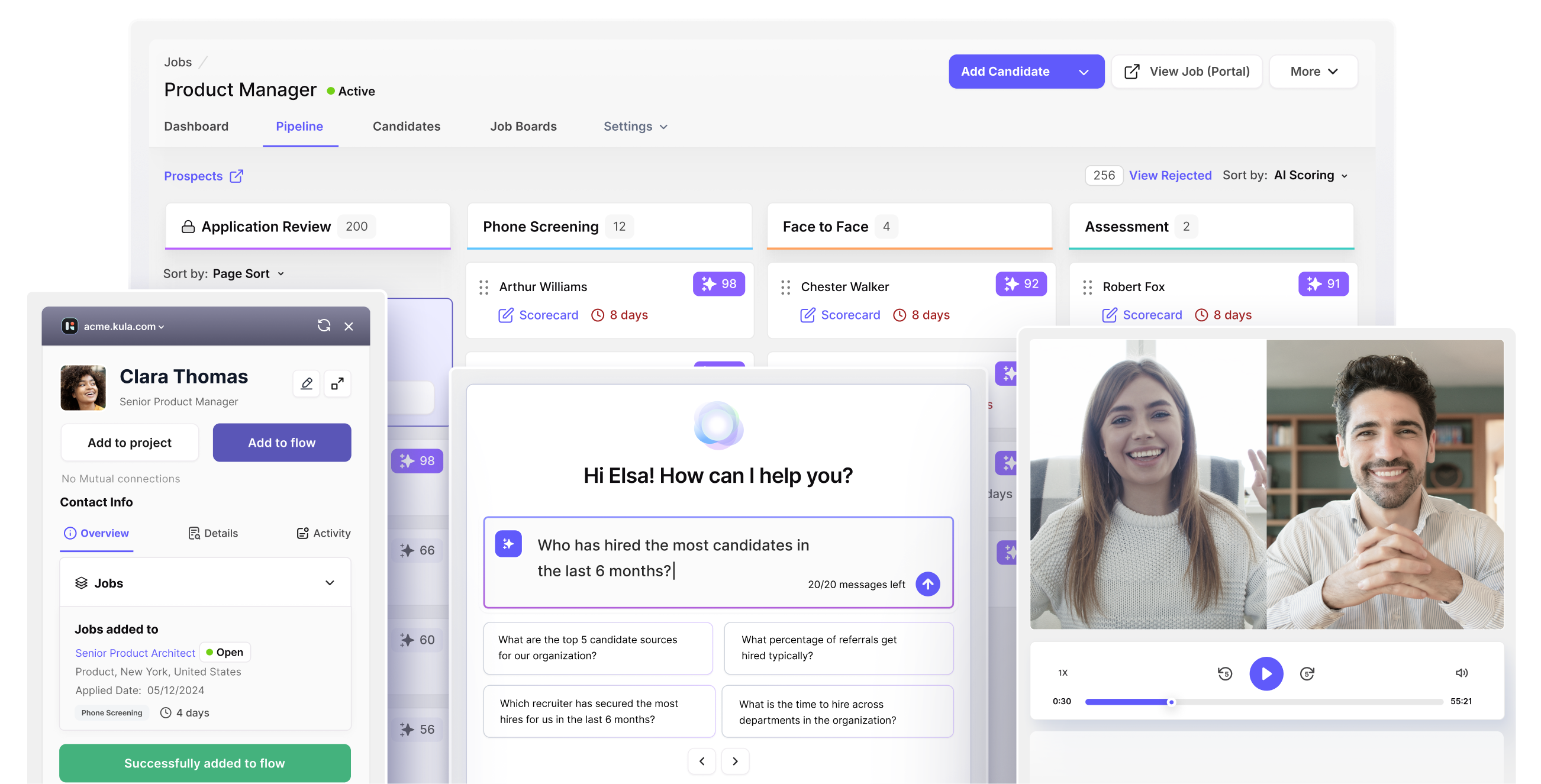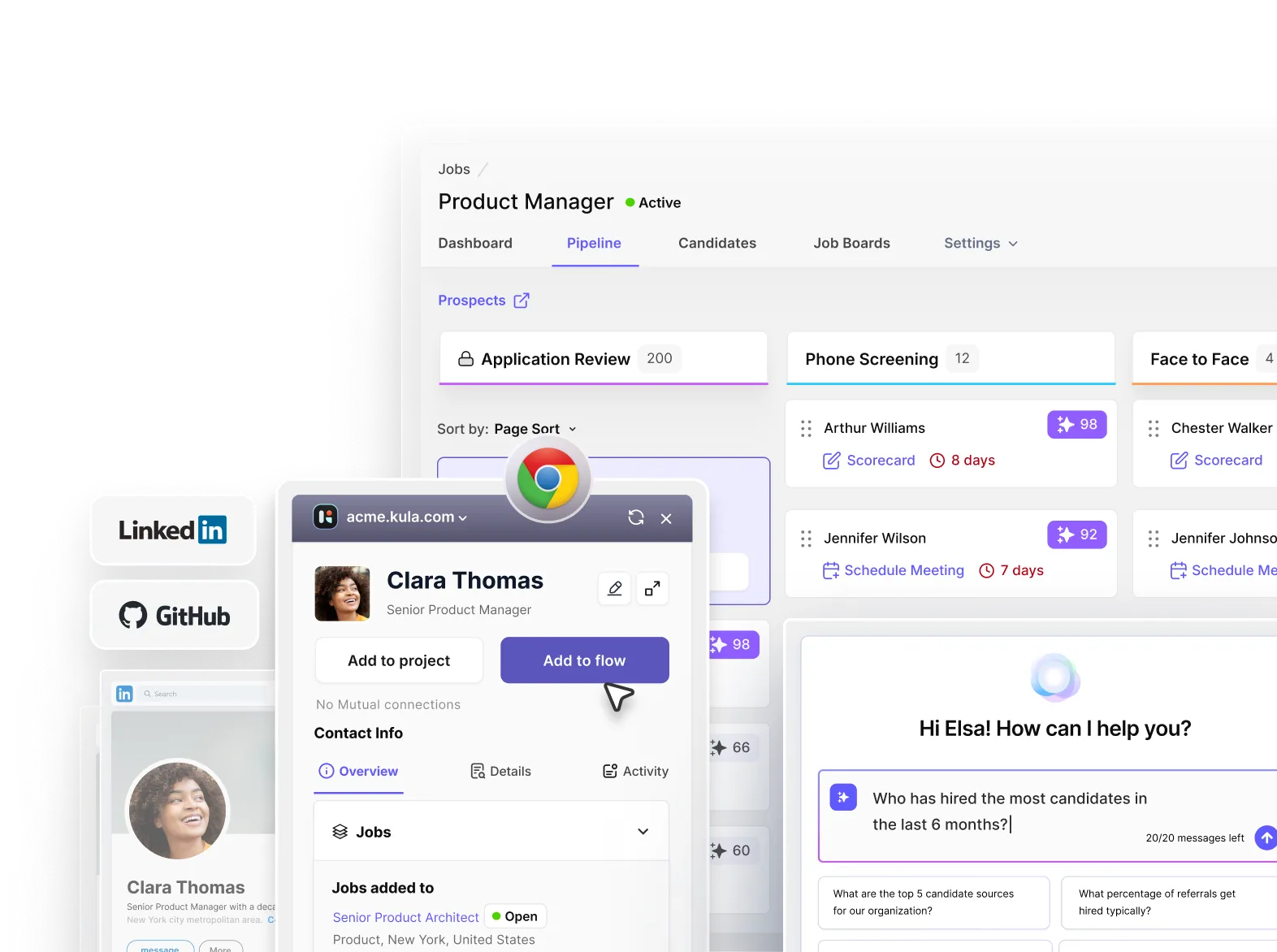Book a 30-minute demo and learn how Kula can help you hire faster and smarter with AI and automation
Recruiting marketing blends marketing with talent acquisition to create a long-term hiring strategy.
Instead of just filling open roles, it focuses on building a strong employer brand and engaging potential candidates well before posting a job.
The goal is to create a ready pipeline of talent.
In this guide, we’ll look into recruiting marketing, why it matters, and how to make a strategy that attracts the right candidates and strengthens your employer brand.
👉TL;DR
- Recruiting marketing is crafting and implementing strategies to attract, engage, and nurture qualified candidates for current and future job openings
- Recruitment marketing is essential for building your company’s credibility, attracting top talent, and reducing both time and hiring costs.
- Key elements of recruiting marketing are employer branding, candidate personas, valuable content, and hiring insights.
- Use multiple channels for candidate sourcing and leverage advanced technologies to speed up the hiring process
- Start by setting SMART goals, personalizing each job opening process, and measuring recruiting KPIs to improve your recruiting marketing strategy.
What is recruiting marketing?
Recruiting marketing is the strategic approach companies use to attract, engage, and nurture potential talent before they apply for a job.
At its core, recruiting marketing involves:
- Creating a compelling employer brand that showcases what makes your company unique, from its culture to its values, mission, and work environment.
- Engage potential candidates with targeted content and communication to establish a connection long before a role becomes available.
- Use multiple marketing tools and channels such as social media, email campaigns, job boards, and paid ads to reach the right audience.
All of this can be divided into 4 key stages:
- Awareness: The candidate learns about your company through content, social media, or word-of-mouth.
- Interest: The candidate expresses interest by following your company or engaging with your content.
- Consideration: The candidate evaluates your company as a potential employer.
- Action: The candidate applies for the job or joins your talent pool for future opportunities.
You can't just post a job opening and hope the right candidates apply, you must actively approach talent, build relationships, and showcase your company as a desirable employer.
The importance of recruiting marketing
1. Attracts top talent
Today’s job seekers are no longer just looking for a paycheck, they’re seeking employers who align with their values, offer career development opportunities, and build a positive work culture.
Recruiting marketing lets you showcase your company’s culture, mission, and employee benefits, helping you stand out in a crowded job market.
By positioning your company as an employer of choice, you attract top-tier talent with the right skills, aligning with your vision and values.
For instance, a company that emphasizes flexibility, work-life balance, and inclusivity in its marketing materials will appeal to candidates who prioritize these qualities in their careers.
This creates a more genuine connection with prospective employees, resulting in a better fit and lower turnover rates in the long run.
2. Building a talent community before you need it
Think of recruiting marketing as networking at a professional conference all year round.
Adobe does this brilliantly.
They don't just reach out when they have an open position. Instead, they:
- Maintain an active social media presence
- Share behind-the-scenes content
- Host virtual and in-person networking events
- Create content that keeps potential candidates engaged
The result?
When a position opens up, they already have a pool of interested, qualified professionals who know and love their brand.
3. Improves candidate experience
Today's candidates expect a seamless, transparent, and respectful recruiting process. recruiting marketing addresses this by:
- Providing clear, comprehensive information about roles and organizational culture
- Ensuring consistent communication throughout the recruiting journey
- Offering insights into what candidates can expect during the interview process
- Creating multiple touchpoints that keep candidates engaged and informed
A positive candidate experience becomes a powerful marketing tool, with satisfied candidates potentially becoming brand ambassadors, even if they aren't immediately hired.
4. Enhances employer brand
A strong employer brand is one of the most powerful tools in recruiting marketing. And a company's reputation is often one of the deciding factors for top candidates.
Recruiting marketing helps you define, shape, and promote your employer brand across multiple channels, ensuring it stands out to prospective employees.
Your employer brand communicates what it’s like to work for your company, your company’s core values, and your approach to work-life balance, diversity, and growth opportunities.
Whether through employee stories, social media posts, or videos, recruiting marketing lets you tell your brand’s story compellingly.
For example, consider a company that promotes diversity and inclusion in its recruiting marketing.
By consistently sharing stories about supporting a diverse workforce, the company differentiates itself from competitors who may need to emphasize these values, ultimately attracting a more diverse talent pool.
5. Optimizing recruiting efficiency
Strategic recruiting marketing can significantly reduce time-to-hire and associated recruiting expenses.
By maintaining an engaged talent pool and leveraging digital platforms, organizations can:
- Reduce reliance on expensive external recruiting agencies
- Minimize time spent on initial candidate screening
- Create a more predictable and controlled recruiting process
- Attract candidates who are already familiar with and interested in the organization
6. Cost-effective recruiting
While traditional recruiting methods often involve expensive job boards, recruiting agencies, or costly advertising, recruiting marketing can be a far more cost-effective solution.
By leveraging the best AI advertising tools, companies can automate and optimize their job ad placements, target the right candidates more efficiently, and significantly reduce recruitment costs.
And by leveraging digital channels like social media, email campaigns, and content marketing, companies can reach a wide audience at a fraction of the cost.
For example, using LinkedIn to post content that showcases your company’s culture or sending out targeted email campaigns can be highly effective without breaking the bank.
Critical elements of a successful recruiting marketing strategy
1. Clear employer brand
Employer brand represents your company’s values and culture and what makes your workplace special.
A strong employer brand will help you stand out in a crowded market and attract candidates who align with your mission and values.
You must define your company's uniqueness to build a strong employer brand.
- What are your core values?
- What sets your workplace apart from others?
Share this information through content, social media, and employee stories to give candidates a clear sense of working for your company.
2. Detailed candidate personas
Candidate personas are fictional representations of your ideal candidates.
You can tailor your messaging, content, and campaigns by creating detailed personas to resonate with specific candidate groups.
To create detailed candidate personas, consider factors like job title, skills, experience, interests, and values.
For example, your marketing team’s ideal candidate will likely differ from your engineering team's.
3. Engaging content
To engage potential candidates, you need to create content that showcases your company culture, highlights job opportunities, and speaks to the needs and interests of your target audience.
Types of content to consider:
- Job descriptions focus on the role's value and your company culture.
- Employee stories through blog posts, videos, or testimonials.
- Social media content that showcases behind-the-scenes moments, company events, and employee achievements.
- Educational content such as webinars, eBooks, or industry insights that position your company as an expert in your field.
4. Data-driven insights
One of the biggest advantages of recruiting marketing is the ability to measure and optimize your campaigns.
By tracking key metrics such as website traffic, engagement rates, and application conversion rates, you can gain valuable insights into what’s working and what isn’t.
Use data to refine your strategy, test different content formats, and experiment with new channels.
Top channels to leverage for recruiting marketing
1. Social media
Social media is one of the most powerful tools for recruiting marketing.
Platforms like LinkedIn, Instagram, and TikTok allow you to connect with active and passive candidates, share content highlighting your company culture, and engage with your audience.
Best practices for social media:
- Post regularly to keep your audience engaged and informed.
- Share authentic content, including employee stories, behind-the-scenes moments, and company values.
- Use paid social media ads to target specific candidate groups based on their interests, skills, and location.
2. Career sites
Your career site is the hub for all your recruiting efforts. It’s where candidates will learn more about your company, your culture, and your open positions.
Key features of a successful career site:
- Clear job listings that are easy to search and filter.
- User-friendly and mobile-optimized.
- Employee testimonials that highlight your company culture.
- Calls to action that encourage candidates to apply or sign up for job alerts.
3. Email marketing
Email marketing is an excellent way to nurture relationships with candidates over time. By building segmented and verified email lists, you can send personalized content and job alerts to keep potential candidates engaged.
Best practices for email marketing:
- Segment your email list based on candidate interests, skills, and experience.
- Craft compelling subject lines and engaging content that encourage opens and clicks.
- Use automation to send timely emails, such as job alerts, company updates, or personalized content, and enhance them with scannable links created using the best QR code solution.
4. Job boards and paid ads
While organic reach is important, paid job ads on platforms like Indeed, Glassdoor, and niche job boards can help you reach a larger audience and fill positions quickly.
Use job boards strategically, focusing on the platforms where your ideal candidates are most likely to be.
Tips for using job boards:
- Promote your company’s values and culture in job ads.
- Use paid social media ads to amplify your employer brand and job openings.
5. Employee referrals
Employee referrals are among the most effective and cost-efficient ways to find qualified candidates.
Encourage your employees to refer candidates from their networks by offering incentives or rewards for successful hires.
The role of technology in recruiting marketing
1. Enhanced candidate sourcing and targeting
With the help of AI-powered tools and data analytics, recruiters can now identify the best candidates from a larger pool with incredible precision.
AI tools helps predict candidate success based on previous hiring patterns. It’s advanced search filters and algorithms help narrow down candidates based on skills, experience, location, and cultural fit to make sourcing smarter and more efficient.
Use platforms like LinkedIn Recruiter, job boards, and social media channels to source potential candidates who match specific job requirements.
2. Automated candidate engagement
Automation tools allow recruiters to engage with candidates more streamlined and timely.
Chatbots, email automation, and recruiting CRMs (Customer Relationship Management) can automatically send personalized messages, schedule interviews, and provide timely follow-ups.
This frees up recruiters’ time and ensures that no candidate falls through the cracks while keeping potential candidates engaged throughout the hiring process.
3. Video interviewing and digital assessment tools
Video interviewing tools have become a staple of modern recruiting, enabling companies to connect with top talent from anywhere in the world.
Use right ATS tool that offers AI to record and transcribe interviews, and fill scorecards for quick candidate review.
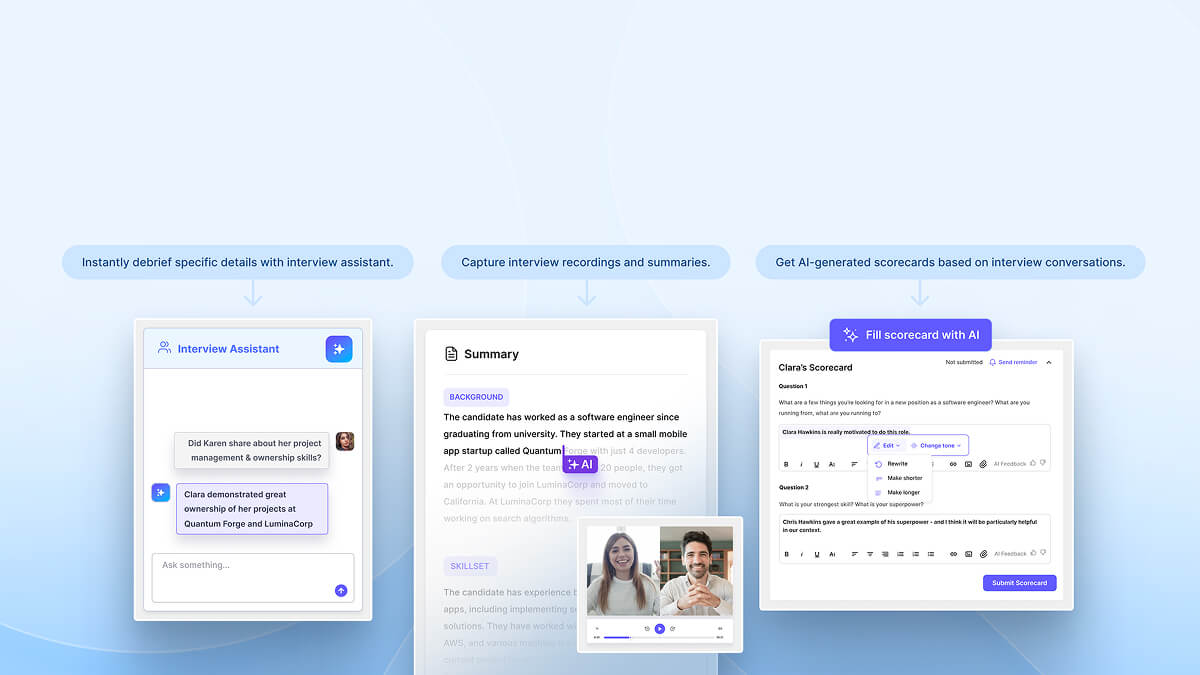
4. Employer branding and social media tools
Technology allows recruiters to showcase their company's culture, values, and team success stories on LinkedIn, Instagram, Glassdoor, and YouTube platforms.
Social media management tools simplify scheduling posts, tracking engagement, and responding to candidate questions.
Social listening tools can even track what candidates are saying about your company and identify opportunities for improvement.
Use the following tools to establish your employer brand:
- LinkedIn Talent Solutions to connect with potential candidates directly.
- Canva to create visually appealing and branded content to post on social media
- Sprout Social and Hootsuite for social media management
- Glassdoor and Indeed to share your values, workplace culture, and employee testimonials
4. Data analytics for candidate insights
Data analytics platforms help recruiters track the effectiveness of their recruiting marketing efforts by providing detailed insights into key metrics.
These tools can show which sourcing channels are most effective, how long it takes to fill a role, and where candidates tend to drop off in the application process.
Recruiters can use this data to determine where to focus their efforts and which strategies are most effective.
5. Recruiting marketing automation
Automation tools allow companies to create and manage their recruiting campaigns at scale.
These platforms can automate outreach, nurture candidates over time, and provide personalized communication, reducing the administrative burden on recruiters.
Whether sending job alerts, setting up interview reminders, or engaging candidates with content, automation tools ensure no potential hire is overlooked.
5 best practices for creating recruiting marketing campaigns
1. Set SMART Goals
Before launching any campaign, define clear and actionable goals using the SMART framework:
- Specific: Your goal should be well-defined, such as increasing website traffic to your career page.
- Measurable: Trackable metrics (e.g., number of applications or increase in social media followers).
- Achievable: Set realistic goals based on available resources and current performance.
- Relevant: Ensure your goals align with your company’s broader recruiting and business objectives.
- Time-bound: Set a specific timeline for achieving the goal, like "Increase applications by 25% within 3 months."
SMART goals provide direction and ensure that you can measure success.
2. Segment and personalize content
Candidates are not one-size-fits-all, so why should your content be?
Personalization is key in recruiting marketing.
Segment your audience based on their job preferences, experience level, or interests, and tailor your content accordingly.
A recent college graduate may respond to different messaging than a senior-level professional.
For example, consider using personalized email campaigns to target candidates who have previously expressed interest in your company or create separate content for different job roles showcasing the specific benefits of working in that department.
3. Use storytelling to highlight your culture
Storytelling is a powerful way to communicate your employer's brand.
Instead of just listing the perks of working at your company, use real-life stories from employees to show what it’s like to be a part of your team.
Share videos, blog posts, or social media updates that feature employee testimonials, day-in-the-life stories, and behind-the-scenes looks at company events.
Candidates connect with stories, they want to know what it’s like to work for you and how your company supports personal and professional growth.
Storytelling makes your recruiting marketing campaign more human, relatable, and engaging.
4. Test, measure, and refine
Recruiting marketing is an ongoing process, and to be truly effective, you need to continuously test and optimize your campaigns.
Run A/B tests on different content formats, headlines, and calls to action to see what resonates best with your audience.
Measure the success of each campaign using metrics like application conversion rates, time-to-hire, and candidate engagement.
Based on this data, refine your strategy to make it more effective.
5. Maintain consistency across channels
Consistency is key to building a recognizable and attractive employer brand.
Your messaging, tone, and imagery should be aligned across all channels, from your career site and social media profiles to your email campaigns and job ads.
This consistency helps reinforce your employer brand and ensures candidates have a cohesive experience when interacting with your company.
Measuring your recruiting marketing success
1. Career site traffic
Your career site is often the first touchpoint for potential candidates.
Are they visiting your site, or is it a hidden gem no one knows about?
Why it matters:
High traffic signals that your outreach efforts (social media, job boards, ads) drive interest. However, you may need to optimize the experience if visitors aren't converting into applicants.
How to measure:
Use tools like Google Analytics or similar platforms to monitor:
- Total traffic: How many people visit your site?
- Traffic sources: Are visitors coming from social media, job boards, or organic search?
Bounce rate: Are they leaving too quickly?
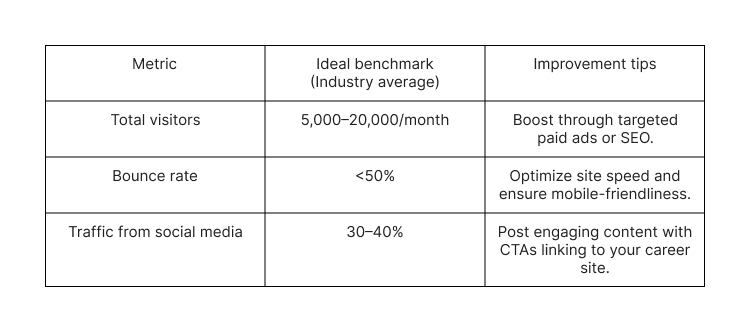
2. Application conversion rates
So, candidates are visiting your career site—great!
But are they completing their applications?
Why it matters:
Low conversion rates often mean your application process is too complicated, time-consuming, or unclear. Remember, nobody wants to upload their resume and manually fill out the same information.
How to measure:
Track how many visitors start and complete the application process.
Pro tip:
- Run A/B tests for application forms. Test different lengths and formats to see what works best.
- Keep application forms short—3–5 fields max for initial submissions.
3. Time-to-hire
Are you filling positions quickly, or do they stay open longer than your competitors’?
Why it matters:
Time-to-hire is a direct indicator of your recruiting efficiency. The longer a position remains unfilled, the higher the impact on team productivity and morale.

💡Pro tip:
Focus on pipeline building by nurturing passive candidates, so you’re ready to act fast when a role opens up.
4. Cost-per-hire
Let’s talk about the dollars. Are you getting value for your spend, or is your budget disappearing without results?
Why it matters:
Cost-per-hire lets you evaluate whether your recruiting marketing efforts are financially sustainable.
How to measure:
Calculate the total spend on ads, tools, and resources divided by the number of successful hires.
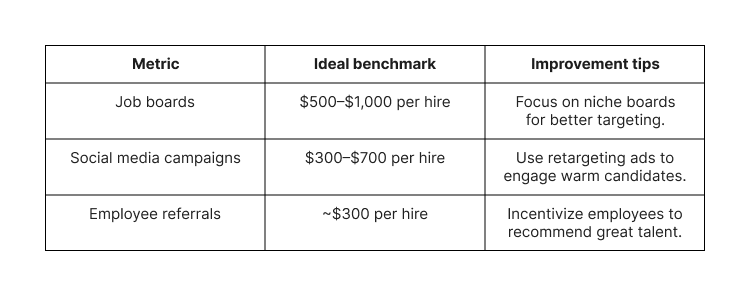
5. Engagement metrics
Engagement is the heartbeat of your recruiting marketing efforts. It shows whether your content is resonating with your audience or falling flat. High engagement means candidates are connecting with your brand and are more likely to consider you as a potential employer.
Why it matters:
Engagement helps build relationships with both active and passive candidates. Strong engagement ensures they stay in your talent pool for future opportunities even if they aren't ready to apply immediately.
How to improve:
- Post authentic, relatable content that showcases your company culture and values.
- Encourage interaction through polls, Q&A sessions, or behind-the-scenes content.
- Personalize your email campaigns with engaging subject lines and targeted content.
Read more: 8 recruiting KPIs and how to measure them for hiring success
Final Thoughts
Recruiting marketing is no longer a luxury, it’s a necessity in today’s highly competitive talent market.
Creating a strategic and proactive approach to attracting and engaging candidates can build a strong employer brand, reduce time-to-hire, and ensure your company is attracting the best talent available.
Remember, the key to a successful recruiting marketing strategy is consistency.
From defining your employer brand to optimizing your content and measuring your success, every step plays a crucial role in building lasting relationships with top talent.
Using these steps, you can create a recruiting marketing strategy to fill immediate job openings and build a talent pipeline to support your company's growth for years.

















